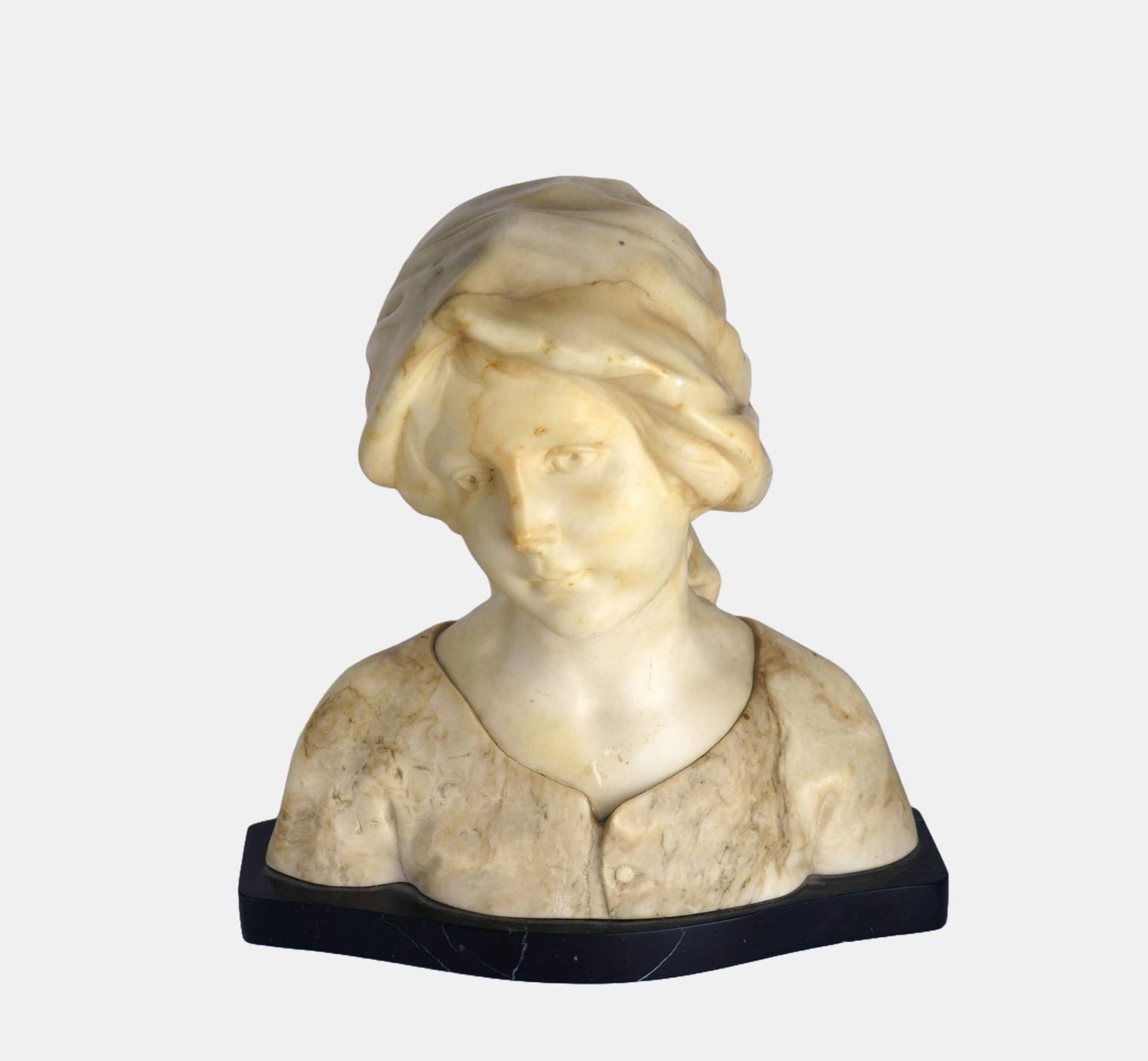Kochendörfer, Fritz (1871-1942), Büste einer jungen Frau mit Kopftuch, um 1910
Fritz Kochendörfer(1871 Mannheim - 1942 Osterode am Harz), Büste einer jungen Frau mit Kopftuch , um 1910. Zweifarbiger Alabaster auf geschweifter schwarzer Marmorplinthe, 24 cm (Höhe) x 22 cm (Breite) x 14 cm (Tiefe), 4,9 kg, rückseitig mit „Kochendörfer fec[it].“ signiert und der Nummer 6 7 90 / II. / 376 versehen, Unterboden mit eingelassener Metallplakette „Kochendörfer. Original Hofkunstanstalt. Medaille für Kunst München 1891.“
- Nasenspitze bestoßen und sehr vereinzelte bestoßene Stellen, zwei kleine Flecke auf dem Kopftuch, sonst in gutem Zustand.
- Abschied von der Kindheit -
Kochendörfer, der sich als Bildhauer in Florenz aufgehalten hatte, schafft hier ein an den Marmorporträtbüsten der Florentiner Frührenaissance orientiertes Werk. Anstatt eines selbstbewussten Blicks in die mit der Renaissance erschlossene Welt hinaus, wie es bei dem um 1460 von Desiderio da Settignano geschaffenen Bildnis der jungen Marietta Strozzi vor Augen steht, verleiht Kochendörfer dem Mädchen einen in sich gekehrten Zug, der die Melancholie des Fin de Siècles verbreitet. Der Kopf ist schräg nach unten gewendet und der Blick nach innen gerichtet. Das Sinnieren ist aber keine drückende Schwermut, sondern verströmt zugleich die Unbeschwertheit kindlicher Unschuld. Das Mädchen ist aber nicht mehr Kind, sie wird zur jungen Frau, so dass das Sinnieren dem wehmütigen Abschied von der eigenen Kindheit gilt.
Der Wandel vom Mädchen zur jungen Frau, die ihr Haar mit einem Kopftuch verhüllt, verleiht der Büste eine erotische Komponente, die durch die sinnliche Erscheinung ihrer Körperlichkeit gesteigert wird. Das anders gefärbte Gewand ist tonal dunkler und von einer Maserung durchzogen, wodurch ihre Haut umso zarter und reiner erscheint. Das Antlitz mit dem graden Nasenrücken, den großen Augen und dem fein geschwungen Mund verleiht der jungen Frau die Aura einer unantastbaren Idealität. Und dennoch wirkt das Gesichts nicht erstarrt, sondern äußerst lebendig, was nicht zuletzt durch die Beimengung von Gelbtönen bewirkt worden ist.
Der Betrachter wird von der Schönheit der jungen Frau angezogen und zugleich dazu animiert, mit in ihr Sinnieren einzustimmen. Dadurch entsteht eine Verbundenheit, auch wenn die Dargestellte ganz in sich selbst versunken ist.
zum Künstler
Fritz Kochendörfer war der Sohn eines Sonneberger Puppenfabrikanten. Damit war ihm die Affinität zur gestalteten Figur in wortwörtlichem Sinne in die Wiege gelegt. Dementsprechend studierte er Bildhauerei an der Münchener Kunstakademie, konnte das Studium aus Geldmangel jedoch nicht zu Ende führen. Nach einem Aufenthalt in Rom und Florenz, wo er sich der Bildhauerei in Marmor widmete, wurde er ab 1896 für die Kunstanstalt Schumacher & Co. in Osterode am Harz tätig.
In der 1887 von Gottfried Schumacher gegründeten Firma wurden auf experimentelle Weise neue Werkstoffe entwickelt, mit denen Marmor imitiert werden konnte. Das zunächst erfundene, auf Gips basierende ‚Chromoplasta‘ hatte nicht die gewünschten Materialeigenschaften, bildete aber die Grundlage, um daraus das ‚Marmalith‘ zu entwickelt, mit dem marmorähnliche Werke gegossen werden konnten. Der ebenfalls gipsbasierte Werkstoff war jedoch wasserempfindlich, weshalb Schumacher ein Gussverfahren aus gemahlenem weißen Marmor entwickelte, um dem Kundenwunsch nach abwaschbaren Oberflächen gerecht zu werden. Mit der weiter zunehmenden Prosperität der bürgerlichen Schicht entwickelte sich ab 1900 zudem eine Nachfrage nach Skulpturen aus echtem Marmor, so dass eine Bildhauermanufaktur eingerichtet wurde.
In der Firma Schumacher eignete sich Fritz Kochendörfer die Techniken des Steingusses an, um sich ab 1899, ebenfalls in Osterode, mit eigenen Werkstätten selbstständig zu machen. Er setzte die Experimente zur Verbesserung der Gussverfahren fort und entwickelte eine Technik der Chromierung, die es erlaubte, dem Kunstmarmor verschiedenartige Farbtonalitäten und Maserungen zu verleihen. Vor allem mit der Produktion seiner wie aus echtem Marmor wirkenden gegossenen Alabasterbildwerke war er derart erfolgreich, dass er in seinen Werkstätten zu Hochzeiten über 100 Mitarbeiter beschäftige. 1913 wurde die Hofkunstanstalt in Kunstgewerbliche Anstalt umbenannt. 1927 erfolgte die Schließung.

